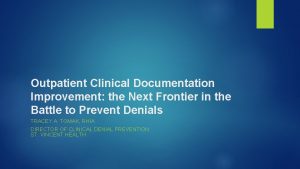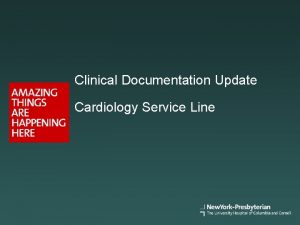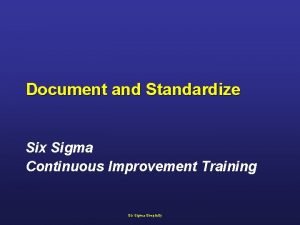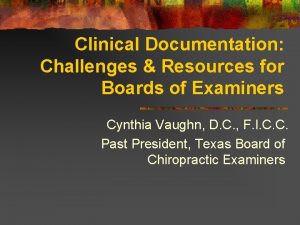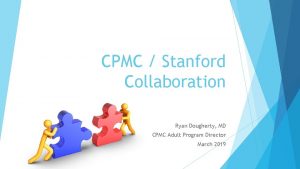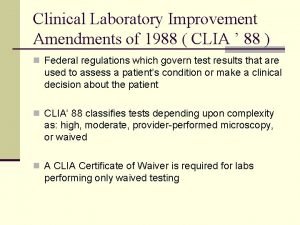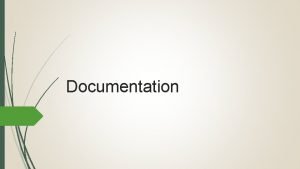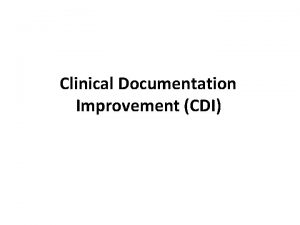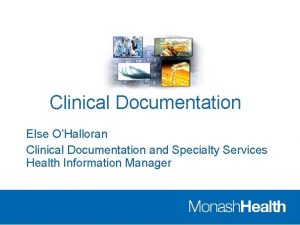Outpatient Clinical Documentation Improvement the Next Frontier in































- Slides: 31

Outpatient Clinical Documentation Improvement: the Next Frontier in the Battle to Prevent Denials TRACEY A. TOMAK, RHIA DIRECTOR OF CLINICAL DENIAL PREVENTION ST. VINCENT HEALTH

Objectives Discuss history of Clinical Documentation Improvement programs The changing healthcare landscape Where to focus efforts today Root-cause analysis Education/training/concurrent/retrospective What does the future look like?

St. Vincent Health System 8 PPS acute care facilities 8 Critical access facilities 3 Behavioral health centers 2 Acute rehab units 3 Ambulatory surgery centers

CDI History According to Wikipedia, Clinical Documentation Improvement is defined as follows: “Clinical documentation improvement (CDI) is the recognized process of improving healthcare records to ensure improved patient outcomes, data quality and accurate reimbursement. ”

CDI History (Continued) The career of the CDI professional began in response to DRGs and gained momentum around 2007. At that time, roughly 30% of hospitals reported having a CDI Program compared to nearly 88% of hospitals today The focus today heavily remains focused on Inpatient documentation

CDI History (Continued) Many factors drove the implementation of and sustained perceived need for the CDI programs we see in the inpatient setting today: Inconsistency in documentation led to increased scrutiny by government and third party payer auditors Undocumented diagnoses and co-morbidities left money on the table due to lower weighted DRG assignments Case mix indexes were low despite the “feeling” that our caregivers were treating sicker patient- thus we needed to either confirm or debunk this idea

CDI History (Continued) In the beginning our medical staff by-in was quite often a “hard sell” for CDI professionals MDs are not trained to document for coding and physician billing did not require a high level of specificity Engaging MDs required a fine balancing act between trying to obtain higher reimbursement and ensuring that the quality and complexity of care as well as severity of illness were adequately documented

The changing healthcare reimbursement landscape While external auditors continue to focus much of their attention on the very fertile soil of DRG audit, the outpatient setting is increasingly becoming a target as well According to the March 2016 Medicare Payment Advisory Commission Report to the Congress: Medicare Payment Policy: hospital inpatient discharges declined by nearly 20% between 2006 and 2014 while outpatient services increased by nearly 44%

The changing healthcare reimbursement landscape (continued) Another factor that has changed for hospitals is the number of employed physicians- a nearly 50% jump from 2010 -2015. In today’s healthcare reimbursement landscape, hospitals as well as physicians now have reason to be concerned with documentation due to various forms of value-based reimbursement models. The burden is increasing and it is now a shared burden- unlike reimbursement days past.

The changing healthcare reimbursement landscape (continued) The new outpatient reimbursement system has introduced us to many new terms: 1. Risk adjustment- an actuarial tool used to predict healthcare costs based on the relative risk of the enrollees in the covered plans (45 CFR 153. 20) 2. MACRA- the Medicare Quality Payment Program with two tracks- the Merit-based Incentive Payment system (MIPS) and the advanced Alternative Payment Models (APMs) 3. HCCs- Hierarchy Category Codes (used by Medicare Advantage Plans)

Change in CDI focus- Why look at Outpatient? Due to the changing focus on outpatient reimbursement and overall quality measurements, physicians and hospitals now share the burden of not only getting paid for services rendered, but also keeping the reimbursement already received and ensuring future reimbursement and possible incentives through reporting positive quality measures

Change in CDI focus- Outpatient setting(s) As previously mentioned, the number of outpatient services continues to grow Meanwhile, estimates indicate that only 10% of hospitals currently have organized outpatient CDI programs Outpatient CDI focus should not only be part of the hospital focus but physician practices should also consider investing in CDI services

Root-cause analysis Some key metrics to consider for a successful outpatient CDI are: 1. E&M coding accuracy 2. Decrease in cases rebilled or held due to coding/billing edits 3. Increase in reimbursement 4. Differences between pre- and post- review claims 5. Charge capture accuracy 6. Other charge trends

Root-cause analysis: Denials Looking at denial history can be on key to starting a successful CDI program It has been said that nearly 90% of all denials are preventable Denial prevention requires dedicated staff to perform root-cause analysis, sufficient data collection tools, timely feedback and continued process improvement efforts in various formats

Root-cause analysis: Denials (continued) One example of outpatient denials is write-off volumes for lack of medical necessity for services provided which are part of a Local or National Coverage Determination (LCD or NDC) There are two ways to review this population of claims- pre-bill and post-bill Following is a case-study of this process done both ways at St. Vincent over the course of FY 16 and FY 17

Case Study- Post-bill review of claims written off due to LCD/NCD (outpatient medical necessity) The St. Vincent revenue cycle operations department has been reviewing denial write-offs consistently since Jan 2015. As part of the review effort, root-cause analysis and process improvement efforts have become a key component of the effort to prevent future denials and avoid appeals and/or writeoffs One category of review began as a post-billing, post- write-off review of claims that did not meet medical necessity for Medicare LCD/NCD

Case Study- Post-bill review of claims written off due to LCD/NCD (outpatient medical necessity) Although St. Vincent had a process in place to review claims prior to billing, this effort took time away from staff in billing, coding and at the facility level as well The DNFB was up and much of the time staff was unable to identify or obtain a qualified diagnosis The result was a multi-million dollar line item write-off across the health system annually (FY 16 data)

Case Study- Post-bill review of claims written off due to LCD/NCD (outpatient medical necessity) Despite review of this line item consistently by staff, the writeoffs continued and very few trends were identified and corrected In order to effectively identify the root-cause of the lack of medically justified diagnoses, the process of review was moved to a dedicated team of three certified coding professionals in March 2016 The team began review of claims at the point of the billing edit

Case Study- Pre-bill review of claims written off due to LCD/NCD (outpatient medical necessity) Medical records were reviewed and data was collected for: Root-cause- lack of MD documented medical necessity, coder missed documentation in the patient record, charge assigned incorrectly, edit incorrect, charge-code mismatch, etc. Action- query to MD, dx added, claim sent back to CDM, claim sent back to coding, claim edit bypassed manually, etc. Outcome- billed with covered dx, GA modified, GZ modified, charge corrected, claim edit correction requested, etc.

Case Study- Pre-bill review of claims written off due to LCD/NCD (outpatient medical necessity) Many root-causes were identified within the first few months of the process 1. Many MDs were sending patients to lab for a battery of tests with only an “Annual physical exam” as the diagnosis 2. Coders were often missing a dx on page 2 or 3 of orders 3. Coders were not coding to the specificity noted in the medical record 4. Coding and charges were not aligned- in the case of screening vs diagnostic tests 5. Edits in the billing system and the claim scrubber did not match or were invalid for the MAC and claims were being held in error 6. ABNs were invalid or not present at all

Case Study- Pre-bill review of claims written off due to LCD/NCD (outpatient medical necessity) As a result of the root-cause data collected, education was provided back to the coding team, front-end registration staff received re-training on use of the medical necessity checking software (and were provided real-life examples from their own facility), edits were corrected in the billing system and claim scrubber and our denial teamed up with the St. Vincent Medical Group for feedback and case examples specific to MDs and their patients By the end of FY 17, St. Vincent had seen a reduction in write-offs for outpatient medical necessity of 46%, saving the organization over 1 M annually so far

Other write-off categories with consistent review Excessive observation for Medicare patients- all claims sent to Case Management monthly for review Short stay write-offs- finding lack of follow-up with payers in notes from case management. Denial RNs have access to all notes and will appeal when possible. Lack of follow-up evident in many claims. 30% penalty for incorrect status or no auth for claims billed as IP. Non-covered services- services that other payers may deem to be not necessary due to lack of covered diagnosis or due to bundling/packaging rules These categories would be among next steps for an organized, focused CDI analysis

Education/training/concurrent/ retrospective Converse to the traditional inpatient CDI programs we are all used to, and as indicated in the previous scenario, outpatient CDI is difficult to manage in a concurrent setting for many services that a hospital provides such as the following: Radiology, lab and other ancillary testing Ambulatory surgery Emergency department Infusion and Wound treatment settings

Education/training/concurrent/ retrospective In the typical outpatient or ambulatory setting, much of the work of CDI will be retrospective analysis and a fine line will need to be drawn to balance obtaining complete documentation and holding up DNFB In addition, education may be just as important for physicians and coders in the beginning of the process since outpatient coding specificity has not been as much of a reimbursement focus in the past on the facility side- for Medicare, CPT has historically driven the APC and payment and many other payers have paid based on contracted amounts (reasonable and customary or percent of charges)

Education/training/concurrent/ retrospective One area that has been a target for auditors in recent years has been the short stay patient. Payers have questioned the need for inpatient charges for patients staying 48 hours or less in a hospital bed and many times even question lengths of stay up to five days due to lack of medical documentation to support severity of the patient’s current condition This area is one which requires a dedicated team of professionals to concurrently and quickly work with physicians to adequately capture all relevant, active and acute conditions to support the appropriate “setting”.

What does the future look like? The growing population of covered individuals continue to consume the majority of their healthcare in the outpatient setting. In response, Medicare and other payers are beginning to collect data in aggregate format by healthcare organization and by physician. Population health is composed of an aggregation of global visits rather than an episodic review by patient.

What does the future look like? (continued) As a result of this aggregated data analysis and new quality measures that will impact the future of reimbursement, the time has come for healthcare facilities and physicians alike to consider adopting some form of outpatient CDI- retrospective or concurrent Outpatient services provided in a hospital BEGIN with the plan of care in the physician office and as such more and more payers are auditing and asking for this plan to be cohesively documented between the physician office and the hospital setting (ex. Blepharoplasty and joint replacements)

Getting started… Determine where to begin data analysis- pre-bill and post-bill internal audit Determine staffing needs- very different skillset than inpatient CDI Determine KPIs/Metrics to measure success Develop policies Develop education materials for registration staff, physicians and coding as needed Engage the help of your EHR vendor for prompts Consistent and timely meetings Focus on quality and the reimbursement will follow


Questions?

Contact Information Tracey A. Tomak, RHIA St Vincent, Indianapolis, IN tatomak@ascension. org
 Outpatient clinical documentation improvement
Outpatient clinical documentation improvement Clinical documentation improvement for cardiology
Clinical documentation improvement for cardiology X.next = x.next.next
X.next = x.next.next Frontier detectors for frontier physics
Frontier detectors for frontier physics Continuous improvement documentation
Continuous improvement documentation Artificial intelligence the next digital frontier?
Artificial intelligence the next digital frontier? Be next frontier software development
Be next frontier software development Alcoac
Alcoac Mental health documentation training
Mental health documentation training Functional quadriplegia query examples
Functional quadriplegia query examples Clinical documentation challenges
Clinical documentation challenges Torrance memorial human resources
Torrance memorial human resources Outpatient parenteral antimicrobial therapy (opat)
Outpatient parenteral antimicrobial therapy (opat) The drug basket method is used dispense medication to
The drug basket method is used dispense medication to Monterey county behavioral health salinas
Monterey county behavioral health salinas Outpatient medical center tallulah la
Outpatient medical center tallulah la Northshore outpatient pharmacy
Northshore outpatient pharmacy Outpatient cdi
Outpatient cdi Cpmc outpatient physical therapy
Cpmc outpatient physical therapy Clia 88
Clia 88 When does the ncsbn begin the next generation nclex
When does the ncsbn begin the next generation nclex Thiếu nhi thế giới liên hoan
Thiếu nhi thế giới liên hoan điện thế nghỉ
điện thế nghỉ Một số thể thơ truyền thống
Một số thể thơ truyền thống Thang điểm glasgow
Thang điểm glasgow Trời xanh đây là của chúng ta thể thơ
Trời xanh đây là của chúng ta thể thơ Số nguyên tố là số gì
Số nguyên tố là số gì đặc điểm cơ thể của người tối cổ
đặc điểm cơ thể của người tối cổ Tia chieu sa te
Tia chieu sa te Bổ thể
Bổ thể Các châu lục và đại dương trên thế giới
Các châu lục và đại dương trên thế giới ưu thế lai là gì
ưu thế lai là gì
